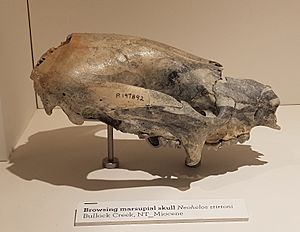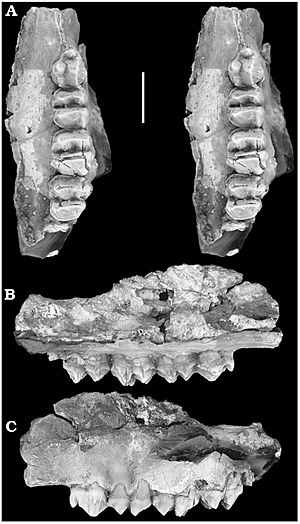Neohelos facts for kids
Quick facts for kids Neohelos |
|
|---|---|
 |
|
| Skull of Neohelos stirtoni at the Melbourne Museum | |
| Scientific classification |
|
| Kingdom: | Animalia |
| Phylum: | Chordata |
| Class: | Mammalia |
| Infraclass: | Marsupialia |
| Order: | Diprotodontia |
| Family: | †Diprotodontidae |
| Subfamily: | †Zygomaturinae |
| Genus: | †Neohelos Stirton, 1967 |
| Type species | |
| Neohelos tirarensis Stirton, 1967
|
|
| Species | |
|
N. tirarensis Stirton, 1967 |
|
Neohelos was an extinct marsupial that lived a long time ago. It existed from the early to middle-Miocene epoch. This animal was a type of diprotodontid, which were large, plant-eating marsupials.
There are four known species of Neohelos: Neohelos tirarensis, N. stirtoni, N. solus and N. davidridei. All these species have been found in Australia. Their fossils come from places like Bullock Creek in the Northern Territory and Riversleigh.
Contents
What Did Neohelos Look Like?
Scientists have found many fossils of Neohelos. These fossils include parts of its skull, jaws, and teeth. For example, N. tirarensis is known from a partial skull and many teeth.
N. solus was identified from a jawbone and a part of the upper jaw. N. davidridei is known from teeth and a piece of its upper jaw. N. stirtoni has the most complete skull found so far, along with jaw parts.
Special Features of Neohelos
Scientists have studied Neohelos fossils very closely. They found some special features that set Neohelos apart from other similar ancient marsupials. These features are mostly about their teeth and skull.
For example, their third premolar tooth (P3) had four bumps, called cusps. It also had a distinct front bump and a moderately developed inner bump. Their first molar tooth (M1) had well-developed bumps and a square shape.
The front lower tooth (i1) was broad and shaped like a spear. It also had a groove on the outside and a ridge on the inside. These unique features help scientists identify Neohelos fossils.
How Is Neohelos Related to Other Animals?

Neohelos includes several different species. Among them, N. davidridei is considered the most advanced. This means it shows many features that are also seen in another ancient marsupial called Kolopsis.
Scientists believe that N. davidridei might have been the ancestor of Kolopsis. Together, Neohelos and Kolopsis belong to a group called Zygomaturinae. Other animals in this group include Zygomaturus and other similar ancient marsupials.
Where Did Neohelos Live?
Neohelos lived in Australia during the early and Middle Miocene epochs. This means it lived millions of years ago. It was one of the few types of large marsupials that lived in both the Bullock Creek area and Riversleigh in the Northern Territory.
These fossils were found in a rock layer called the Wipajiri Formation. This formation helps scientists understand the environment where Neohelos once roamed.
Further Reading
- The Book of Life: An Illustrated History of the Evolution of Life on Earth by Jean-Paul Tibbles, Peter Andrews, John Barber, and Michael Benton
- Prehistoric Mammals of Australia and New Guinea: One Hundred Million Years of Evolution by John A. Long, Michael Archer, Timothy Flannery, and Suzanne Hand
See also
 In Spanish: Neohelos para niños
In Spanish: Neohelos para niños

